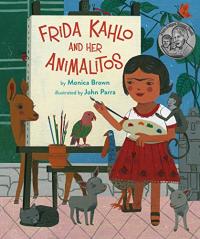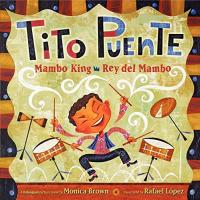
Lola Levine and the Ballet Scheme
Find This Book
ISBN 031625844X
Purchase on Amazon
ISBN 031625844X
Purchase on AmazonWith a little parental scheming, Lola and Bella discover friendship and how ballerinas and soccer players just may have complementary skills.

Julianita is excited to receive her very own caterpillar to raise at school! Yet when her caterpillar, Tiger, finally emerges from his chrysalis, Julianita doesn’t want to let him go. She worries that he will get lost on his way to Mexico. “Tiger knows the way to Mexico because it’s in his heart,” her Abuelito reassures her. She feels sad to see Tiger fly away, but Julianita knows that someday, she will follow him to back to her grandfather’s beloved homeland.

Chavela loves chomping chicle — chewing gum and blowing bubbles. One day, while out with her abuelita, she finds a mysterious kind of gum she has never seen before. She pops it in her mouth and blows a giant bubble that lifts her up into the air and carries her on a magical journey. Candy-colored paintings illustrate this fantastical story with an ecological twist. An afterword provides information on natural chewing gum, the rainforest, and sustainable farming, as well as music to a traditional Latin American folksong.

Meet Clara, a little girl who is very, very grumpy. Mami is tired of Clara’s grumpy face, so she sends her daughter to the curandera — or healer — down the hall. The curandera knows just what Clara needs — to help her neighbors! Readers will cheer for Clara as she learns to focus on others rather than herself in this charming story.

Featuring charming visuals and lively, often lyrical prose, this picture book introduces Mexican artist Frida Kahlo, interweaving biographical details while highlighting her special relationships with pets. Folk-art style illustrations vividly evoke the Mexican environment.

Starring on the soccer field comes more easily to 7-year old Lola than being Squirrel #2 in the class play. But in characteristic Lola fashion, she rises to the occasion to avert a drama disaster in this laugh out loud saga!

Marisol is truly a nonconformist. She doesn’t like things that match, doesn’t want just one theme for her birthday, and the only gift Marisol really wants is a visit from her abuelita. The surprise at her “Clash Bash” party is a virtual visit from her grandmother. Joyful illustrations accompany this second fun-filled, bilingual Marisol story.

Marisol McDonald likes the letter M and most words that begin with it. Except for MONSTER. The night noises Marisol hears turnout not to be a monster at all. The satisfying story is recognizable, reassuring and entertaining, presented in both English and Spanish.

Meet Marisol McDonald, a spunky young girl with fiery red hair and brown skin who wears green polka dots with purple stripes, mixes English and Spanish, and eats peanut butter and jelly burritos. Everyone tells her she doesn’t match, until one day she tries matching — and discovers that it makes her miserable. At the end of the day, however, her teacher shares a special secret with her and lets her know she likes Marisol for who she is: a creative, bilingual Peruvian-Scottish-American! This poignant story, based on Monica Brown’s childhood, celebrates each individual’s uniqueness and reminds children that it’s ok not to fit into boxes that other people may put you into. Bilingual text.

The beautiful artwork of this award-winning picture book about salsa queen Celia Cruz practically jumps off the page, and conveys the spirit and rhythmic energy of her music. Learn about Cruz’s childhood in Havana and her entry into the world of salsa music from vibrant illustrations and text presented in English and Spanish.

As she did in My Name Is Celia/Me llamo Celia, Monica Brown tells the story of young Gabriel García Márquez’s life in this bilingual picture book. Brown also provides children with a simple introduction to magical realism by showing how young Gabriel’s surroundings and imagination merged in fantastic ways, fostering his creativity and building the foundation for the legendary characters and stories he would later create. Beautiful illustrations complement the lyrical text.

“My name is Gabriela Mistral. It is a name I chose myself because I like the sound of it.” With these words, Monica Brown introduces us to the Chilean poet and author who, in 1945, became the first Latin American writer to win the Nobel Prize in Literature. The lyrical text and exquisite illustrations bring Gabriela’s childhood and talent to life for young readers.

Neftali always loved nature and words. This fondness allowed Neftali — better known as Pablo Neruda — to create poetry in a “voice [that] was heard across nations and ocean.” Rich language and lush illustrations that incorporate words in Spanish and English are sure to enthuse young writers while introducing this Nobel-winning poet.

Did you know that as a boy, Pelé played soccer in bare feet with a grapefruit instead of a soccer ball? Monica Brown shares the inspirational story of the beloved soccer star’s rise from humble beginnings to becoming El rey del fútbol. Rudy Gutiérrez’s brilliant and fluid illustrations of Pelé and “the beautiful game” of soccer leap off the page. Bilingual text. Curriculum guide (opens in a new window) available.

A fascinating bilingual picture book biography of Peruvian archaeologist and national icon Julio C. Tello, who unearthed Peru’s ancient cultures and fostered pride in the country’s Indigenous history.

Many years ago in California, an energetic young Girl Scout named Dolores worked to raise money for soldiers fighting in World War II. A thoughtful young boy named Cesar worked in the fields to help his family put food on the table. As young adults, these two extraordinary individuals would meet and spend the rest of their lives working tirelessly on behalf of migrant workers and children through nonviolent struggle — side by side. Monica Brown and Joe Cepeda bring the story of Dolores and Cesar to life through this vibrant bilingual book, which will make an excellent addition to units on migrant farmworkers, civil rights, or women’s history.

Tito Puente was born to be a musician. He grew up to become the Mamba King to whose music people danced the mambo, rumba, and cha-cha. Rhythmic language — in English and Spanish — and animated illustrations briefly present Tito’s life and the impact of music throughout.

Meet Ana, a young girl who loves to read. There aren’t many books in her small Colombian village, though — until the day Ana meets the Biblioburro, a librarian who brings books through the mountains on the backs of two strong donkeys. Inspired by the heroic efforts of real-life librarian Luis Soriano, this story asks readers, “How far would you go for a book?”